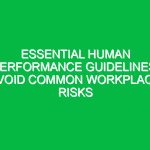“`html
Essential Insights: How What We Do at Home Affects Work Safety
Good morning team! Today, we’re diving into an important topic that connects our everyday lives at home to our safety and well-being at work. It might seem like our home life and work life are two separate worlds, but the reality is that what we do at home significantly impacts our performance and safety in the workplace. Understanding this connection is vital for maintaining a safe work Environment for everyone.
Understanding the Impact of Home on Workplace Safety
What does it mean when we say that our home life affects our work safety? Essentially, the habits and practices we engage in outside of work can directly influence our physical and mental state when we are on the job. For example, lack of sleep, stress from personal issues, or even unsafe practices at home can lead to decreased focus, increased fatigue, and a higher likelihood of accidents at work.
Many employees underestimate how their home lives can affect their work performance. Misconceptions include thinking that what happens at home is irrelevant to their job or that their personal life challenges won’t spill over into their work. However, studies show a strong correlation between home life and workplace injuries or incidents.
Key Hazards, Risks, and Safety Considerations
Let’s explore some specific Hazards and risks that can arise from our home environments:
- Fatigue: Poor sleep due to stress or late-night activities can lead to decreased alertness and slower reaction times at work.
- Distractions: Ongoing issues at home, such as family disputes or financial worries, can distract us during work, increasing the chances of accidents.
- Unsafe Practices: Engaging in unsafe practices at home, like improper lifting techniques or neglecting to use Safety Gear while doing DIY projects, can lead to injuries that carry over to the workplace.
- Health Impacts: Chronic stress or health issues stemming from personal life can affect mental clarity and decision-making abilities at work.
Ignoring these risks can have real-world consequences. For instance, an employee who is sleep-deprived may not notice a safety hazard or may make a critical mistake that jeopardizes their safety or that of their colleagues.
Best Practices, Procedures, & Actionable Advice
Now that we understand the connection between home life and Workplace Safety, let’s discuss some Best Practices that can help mitigate these risks:
- Prioritize Sleep: Aim for 7-9 hours of quality sleep each night. Establish a bedtime routine that allows you to wind down and prepare for restful sleep.
- Manage Stress: Incorporate stress management techniques such as yoga, meditation, or even simple breathing exercises to help you cope with challenges at home.
- Communicate: Keep an open line of communication with your supervisor and coworkers about any issues that may be affecting your work performance. This can lead to support and understanding.
- Follow Safety Protocols: Whether at home or work, always adhere to safety practices. If you’re doing home repairs, use proper lifting techniques and wear appropriate safety gear.
- Stay Physically Active: Regular exercise can improve your physical and mental well-being, which can enhance your focus and energy levels at work.
For example, consider the experience of a worker who was involved in a minor accident at home due to improper lifting techniques while moving furniture. This worker came to work with back pain, which distracted him during a critical Operation, leading to a workplace incident. By adhering to Safe Practices at home, he could have prevented the injury and its consequences at work.
Regulations, Standards, and Compliance
It’s essential to remember that many Workplace Safety standards, such as those set by OSHA, are in place to protect you and your coworkers. These Regulations encompass various aspects of safety, from equipment use to personal health and wellness.
Compliance with these safety Standards is critical as it helps minimize risks and ensures a safer work environment. When employees practice safety at home, it reinforces a culture of safety that translates into the workplace, leading to fewer accidents and a more productive work environment.
Employee Engagement & Discussion
Now, let’s take a moment to reflect on our own experiences. I’d love to hear your thoughts:
- What safety challenges have you encountered related to your home life?
- How do you ensure that your personal issues do not affect your work performance?
- Can you share any tips or strategies that have worked for you in maintaining a balance between home and work safety?
Your insights and experiences are valuable and can help foster a culture of safety where we support one another in both our personal and professional lives.
Conclusion & Key Takeaways
In conclusion, it’s clear that what we do at home plays a significant role in our work safety. By understanding the connection and taking proactive steps to manage our home life, we can improve our focus, reduce risks, and ensure a safer workplace for everyone. Remember to prioritize your well-being, communicate openly, and practice safety at all times.
Thank you for your attention today and for your commitment to making safety a top priority. Together, we can create a safer work environment by recognizing the importance of our home life and its impact on our professional responsibilities.
“`


